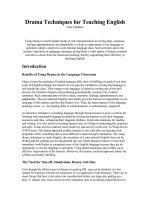PRINCIPLES FOR TEACHING WRITING
Bạn đang xem bản rút gọn của tài liệu. Xem và tải ngay bản đầy đủ của tài liệu tại đây (53.07 KB, 2 trang )
PRINCIPLES FOR TEACHING WRITING
1. Emphasize that writing is a means to commmunicate meaning,
about oneself and the real world. It is not just using a grammatical structure
correctly – or writing with clear penmanship.
2. Start with controlled activities and later ask the students to
communicate more freely. (For controlled, directed, and tree exercises and
activities)
3. Early in the course, have the students write about concrete subjects.
These include physical descriptions of people and places and tangible topics
like food, animals, school, and home.
4. Practice the use of basic action words and language functions early
in the course. These include words like eat, sleep, study, walk, run and drive
and functions like introducing, describing, giving information, and asking
questions. Later add more difficult verbs and functions. As the students’,
writing ability progresses, they can practice writing about more abstract
things like ideas, opinions, and feelings.
5. Whenever possible, relate the writing assignments to the speaking
topics from class. This will help to integrate the skill areas and give the
students additional practice with the same functions, vocabulary, and
structures.
6. Expect the level of writing to be higher than the level of speaking.
Because students have more time to communicate clearly when writing than
when speaking, the standard of correctness should be higher. This includes
appropriate use of words and correct use of grammar. This does not mean
the students should write perfectly, but it does mean they should be more
careful.
7. Provide an audience broader than just the teacher. Whenever
writing, the writter should be aware of who the reader is. The teacher should
always specify who the “audience” or “readers” is. Do this by making
statements such as:
Write this story for your calssmates.
Write this letter to an American child.
Write this composition for your mother.
Write this note to your best friend.
We write differently, depending on whom we are writing to, it is not natural
to always write for the teachers, so other people should be included as
readers.
8. State a purpose for the assignment. Your writing assignment should
answer the question, “why am I writing this?” Give your students a purpose
so they know why they are writing:
“These are directions to your apartment for a new friend”.
“This is a letter to your cousin.”
“This is a thank-you note to your father”.
“Imagine these are advertisements for the newspaper”.
Also, if you have your students write a letter to a friend or a story for their
parents, encourage them to give it to the friend or parents. This is more
natural use of language.
9. Provide several kinds of feedback – Sometimes speak directly to
your students about their writing. Other times write comments to them on
their papers. Other times let their fellow students read and comment on their
papers. The feedback should be specific and related to what has been taught.
Also, the feedback should not be overly negative. Always try to find positive
encouragement and compliments to tell the writers. This will balance the
corrections and criticism.
10. As in speaking, provide topics of interest for the students to write
about. Motivation is important for language learners and interesting topics
increase motivation. Ask your students what kind of topics they would like
to write about.









